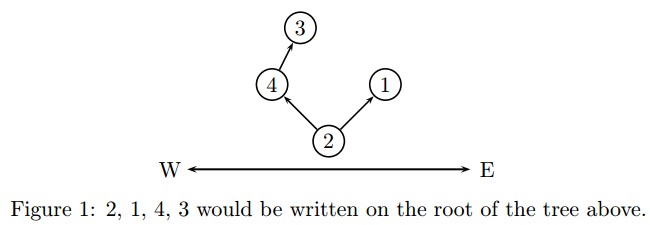Elves
are very peculiar creatures. As we all know, they can live for a very
long time and their magical prowess are not something to be taken
lightly. Also, they live on trees. However, there is something about
them you may not know. Although delivering stuffs through magical
teleportation is extremely convenient (much like emails). They still
sometimes prefer other more “traditional” methods.
So, as a
elven postman, it is crucial to understand how to deliver the mail to
the correct room of the tree. The elven tree always branches into no
more than two paths upon intersection, either in the east direction or
the west. It coincidentally looks awfully like a binary tree we human
computer scientist know. Not only that, when numbering the rooms, they
always number the room number from the east-most position to the west.
For rooms in the east are usually more preferable and more expensive due
to they having the privilege to see the sunrise, which matters a lot in
elven culture.
Anyways, the elves usually wrote down all the
rooms in a sequence at the root of the tree so that the postman may know
how to deliver the mail. The sequence is written as follows, it will go
straight to visit the east-most room and write down every room it
encountered along the way. After the first room is reached, it will then
go to the next unvisited east-most room, writing down every unvisited
room on the way as well until all rooms are visited.
Your task is to determine how to reach a certain room given the sequence written on the root.
For instance, the sequence 2, 1, 4, 3 would be written on the root of the following tree.

E
WE
EEEEE
序列给出的是dfs序,所以只要计算出每个结点的左右子树的结点数。规定右树代表‘E‘方向。
因为roomId小的优先访问,所有当当前结点roomId为a[u]的时候,只需要知道前面已经访问过的roomId比a[u]更小的有多少个
就知道a[u]的右树中有多少个子节点。这个信息可以用树状数组维护。要知道左树上的结点数量就在dfs的时候再维护一个信息,当前树上结点的总数量tot。
把询问离线,dfs的时候记录路径,到达一个询问的点的时候记录答案。
#include<bits/stdc++.h>
using namespace std;
const int maxn = 1e3+100;
int n;
int C[maxn];
#define lowbit(x) (x&-x)
int sum(int x)
{
int ret = 0;
while(x > 0){
ret += C[x]; x -= lowbit(x);
}
return ret;
}
void add(int x,int d)
{
while(x <= n){
C[x] += d; x += lowbit(x);
}
}
string ans[maxn];
int qry[maxn];
bool mark[maxn];
int a[maxn];
char path[maxn];
bool vis[maxn];
void dfs(int u = 1,int f = 0,int d = 1,int tot = n)
{
if(vis[u] || tot <= 0) return;
vis[u] = true;
if(mark[a[u]]){
ans[a[u]].assign(path+1,path+d);
}
add(a[u],1);
if(tot == 1) return;
int ct = a[u]- sum(a[u])+1;
int rst = u+ct;
if(rst>u+1 && u < n) {
path[d] = ‘E‘;
dfs(u+1,u,d+1,ct-1);
}
if(rst>u && rst<=n){
path[d] = ‘W‘;
dfs(rst,u,d+1,tot-ct);
}
}
int main()
{
//freopen("in.txt","r",stdin);
int T; scanf("%d",&T);
a[0] = 0; path[0] = ‘*‘;
while(T--){
scanf("%d",&n);
for(int i = 1; i <= n; i++) scanf("%d",a+i);
int q;
scanf("%d",&q);
memset(C,0,sizeof(C));
memset(mark,0,sizeof(mark));
for(int i = 0; i < q; i++){
scanf("%d",qry+i);
mark[qry[i]] = true;
}
memset(vis,0,sizeof(vis));
dfs();
for(int i = 0; i < q; i++){
printf("%s\n",ans[qry[i]].c_str());
}
}
return 0;
}
